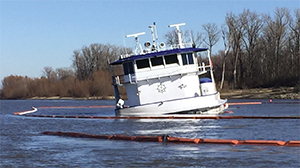Federal investigators say a towboat pilot’s failure to hold position along the riverbank was a leading factor in a 2015 collision on the Mississippi River near Memphis, Tenn.
Barges guided by the downbound towboat Margaret Ann struck the stern of the towboat William E Strait at about 1122 on Dec. 14, 2015, at mile marker 727.4. William E Strait took on water and partially sank, while Margaret Ann’s lead barge broke away. Nobody was hurt on either towboat, and total damage was estimated at $2 million. About 700 gallons of diesel and other oils escaped into the river.
The NTSB cited the “William E Strait pilot’s inability to hold his vessel in a position along the left descending bank, as had been agreed on, to allow the safe and unimpeded passage of the Margaret Ann” as the probable cause of the accident.
The 7,200-hp twin-screw William E Strait was pushing 30 200-foot gravel barges downriver to New Orleans when it brushed against the Valero West Memphis Terminal barge dock at about 1530 on Dec. 13 — the day before the collision. After the impact with the dock, the crew steered the tow across to the river’s left bank for a U.S. Coast Guard inspection.
The Coast Guard cleared the towboat to continue downriver the next morning at about 0930, but it remained along the left bank awaiting a delivery of food and supplies, the NTSB report said. Meanwhile, the 3,000-hp twin-screw Margaret Ann was approaching Memphis pushing three 297-foot tank barges loaded with asphalt. The tow was bound for Baton Rouge, La.
During this period, William E Strait was about 500 feet into the river while the lead barges were on the riverbank. The crew identified an upstream eddy that was pushing the towboat toward the center of the river. The pilot used flanking rudders and slight astern propulsion to maintain position. However, investigators determined William E Strait slowly shifted away from the bank for more than an hour leading up to the collision.
Shortly after 1100, Margaret Ann’s pilot hailed William E Strait over radio to make passing arrangements. The plan called for William E Strait to slowly back off the river-bank and hold position while the other tow passed, the report said. After that, William E Strait was to come off the bank and resume its voyage downriver.
As the vessels prepared to meet, there were signs William E Strait was deviating from that plan.
“As the Margaret Ann approached mile marker 728.8, the pilot noticed both visually and on the ECS display that the William E Strait was maneuvering in a manner … not consistent with the initial passing arrangement,” the report said. “Specifically, he told investigators that he was concerned the stern of the William E Strait was ‘coming out toward the middle of the channel.’”
Over radio, William E Strait’s pilot told his counterpart on Margaret Ann that he planned to apply propulsion ahead to bring the stern away from the channel. However, the move backfired and the vessel swung away from the riverbank. The combined length of the vessel and its tow was 1,185 feet.
Margaret Ann’s pilot recognized a collision was imminent and took action to minimize the damage. He put the rudder hard to starboard and the throttle full ahead in an effort to keep his raked lead barge, MM-66, from riding onto William E Strait’s stern. Just before the collision, Margaret Ann was traveling at 9 knots.
“The aft port side of barge MM-66 and the port bow of barge MM-41B struck the aft starboard corner of the William E Strait hull,” the report said, adding that MM-66 sustained a hull penetration to its stern void and also broke away from Margaret Ann.
William E Strait sustained a 6-by-5-foot breach in its stern, and its engine room was soon flooding. After impact, William E Strait moved back toward the bank with help from another towboat while Margaret Ann and another vessel retrieved MM-66.
The NTSB cited William E Strait’s failure to maintain position on the riverbank. Although investigators acknowledged the river current was “acting on the port aft area of the vessel and its tow,” they also determined the pilot’s attempt to stem the motion away from the bank was “neither timely nor effective.”
The 184-foot William E Strait is a 62-year-old towboat owned by Smithland Towing & Construction and operated by Western Rivers Boat Management of Paducah, Ky. Jason Strait, a Western Rivers vice president, declined to comment on the NTSB findings. As of September, he said the towboat was tied up at Western Rivers’ dock awaiting repairs and refurbishment.
The 105-foot Margaret Ann, built in 2015, is owned and operated by Magnolia Marine Transport Co. of Vicksburg, Miss. Company executives did not respond to phone messages seeking comment on the NTSB findings.

